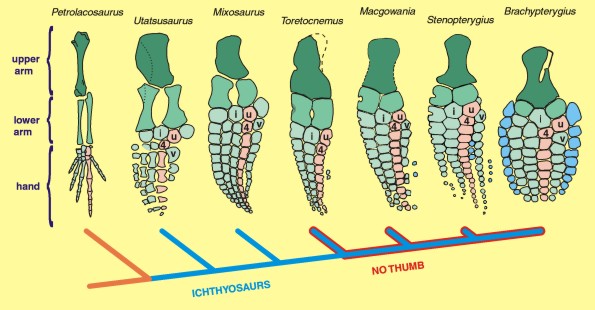Ichthyosaur Forefin
Ichthyosaur Forefin
a mirror of some the content of Ryosuke Degus's excellent webpage on Ichthyosaurs
in memory of Australia's Ichthyosaur hunter Mary Wade 1928-2005
2-1. FOREFIN OF ICHTHYOSAURS
Even the earliest ichthyosaurs had flippers, or fin-shaped limbs. There are many ways to call them, but it has become customary among paleontologists over the past few decades to call the front pair forefins, and the back pair hindfins.
Ichthyosaurs probably used their forefins to maneuver during swimming, as in living fishes and cetaceans (dolphins and whales). Some paleontologists have suspected that certain ichthyosaurs used their limbs for propulsion, but it seems that their shoulders and hips were not very robust, unlike in vertebrates that use their limbs for propulsion.

The limb skeletons went through a drastic modification as ichthyosaurs evolved. You can clearly see it by plotting the shape of the forefin skeleton along the family tree of ichthyosaurs, as in the above figure.
You can make the following observations about the evolution of forefin skeletons in ichthyosaurs: (1) The lower arm bones became shorter and shorter along the family tree, although there are exceptions; (2) The finger bones also became shorter and shorter, and eventually became disk-shaped; (3) The number of finger bone increased early in the evolution; (4) The thumb disappeared at one point, and then additional digits (light blue) appeared on both sides of the remaining digits.
see also... ICHTHYOSAURS INTRODUCTION FOREFIN EYES VERTEBRAE SIZE DIETS SWIMMING DIVING PHYLOGENY MARY WADE LITERATURE COPYRIGHTS back to Earth Science Australia...

